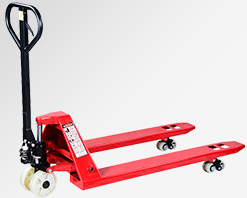News Details
Operation skills of manual hydraulic handling vehicle
When the manual hydraulic handling vehicle is in operation, when the operator presses the handle up and down, it drives the piston in the hydraulic pump to move, and presses hydraulic oil from the oil tank into the hydraulic cylinder. As the oil pressure increases, the plunger inside the hydraulic cylinder is pushed up, and the thrust is transmitted to the fork through a mechanical connection device. The return valve controls the return of hydraulic oil, and when the valve is opened, the fork slowly descends under its own weight. Although this system is simple, it can generate enough lift to easily lift several tons of wood.
Proper forklift lifting techniques can significantly improve work efficiency in the operation of a lumber mill. When inserting into the bottom of the wood, the fork should be lowered to the lowest position and slightly tilted forward to make it easier for the front end of the fork to slide in. When lifting, the handle should be steadily pressed to avoid sudden force causing the wood to shake. For longer boards, the segmented lifting method can be used: first slightly lift one end to check balance, and then fully lift it. During the transportation process, keep the forks tilted backwards to prevent the load from slipping off. When unloading, the lowering valve should be slowly opened to ensure a smooth landing of the fork and avoid impact on the wood.

Safety precautions are an essential part of the operation process that cannot be ignored. When lifting the fork, it is necessary to ensure that the wood is stacked evenly and the center of gravity is located in the center area of the fork. Overloading is strictly prohibited. A common mistake in timber factories is to transport too many boards at once, which can easily lead to hydraulic system overload and failure. During the lifting process, the operator and surrounding personnel should stay away from the movement range of the fork to prevent injury. Regularly check the hydraulic oil level and quality, and promptly repair any leaks or insufficient pressure found. When the ambient temperature is low, several no-load lifting movements should be carried out first to reach the working temperature of the hydraulic oil before carrying out load operations.
Special techniques for wood handling can further improve operational efficiency. For cylindrical materials such as logs, anti roll frames can be installed on the forks or specialized fixtures can be used. When dealing with smooth surface boards, it is recommended to install rubber pads on the fork surface to increase friction. When handling multiple layers, wooden pads should be placed between each layer to maintain stability. When transporting particularly long timber, two transport vehicles can work together, but it must be commanded by experienced personnel to ensure synchronized actions.

